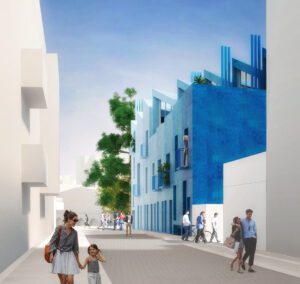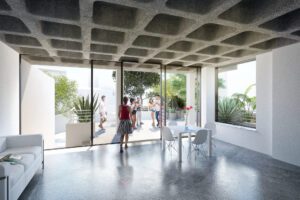
The seven diverse buildings, each executed in a different colour and material, add 60 rental homes in a variety of styles and sizes intended for local inhabitants who work in the surrounding area, as well as additional commercial space. The many bright colours, emphasised by the Mediterranean sun, advertise the vibrancy and rejuvenation of the neighbourhood. Each of the buildings brings not only its own character, but also unique amenities, with facilities such as restaurants and bars being public while amenities such as pools are accessible to residents of all buildings within the plan.
Five of the buildings of Project Gomila are already under construction. The largest building, at the heart of the ensemble, is the Gomila Center, a renovation of a 1979 design by architect Pere Nicolau. Also included in the first phase is Las Fabri-Casas, a set of blue row houses with a saw-tooth roof, the red townhouses known as Las Casitas, a sustainable apartment building built in rammed earth and, directly adjacent to Plaza Gomila, the green building simply named La Plaza, which transforms an existing building. A later phase will add two further buildings to the ensemble: the yellow Casa Virginia, and a small construction next to the Gomila Center, both renovations of existing neighbourhood buildings.

“By mixing new buildings and reused structures, we rejuvenate the neighbourhood while maintaining the connection to its illustrious past”, says MVRDV founding partner Jacob van Rijs. “Renovating the Gomila Center is not only ecologically sustainable, reusing the building in line with principles of circularity, but also offers a reminder of the history of the area.”
“We wanted to create a social, human neighbourhood in which all people would feel at home”, adds MVRDV founding partner Winy Maas. “The colour palette matches the sunny Mallorca, from terracotta and earth tones to bright blue and red. Because the roofs are cut in different ways – one stepped, one sloped, one with jagged gables – a diverse, recognisable district is created.”
“The project goes beyond architecture or building design”, says Guillermo Reynés, the founder of GRAS Reynés Arquitectos and a native of Palma. “It creates a sense of community, a ‘Gomila belonging’ – something that has been missing for a long time in this part of the city but that has always been present in the memory of generations of Palmesanos. It is a unique opportunity, and a challenge that also brings a lot of responsibility.”
“Project Gomila is not just a mass of buildings; it is a concept that adds value to the neighbourhood via an effective public-private venture, including a unique residential housing project”, says the Fluxà family. “It restores the identity of the community square, which was a centre of avant-garde nightlife from the 1950s to the 1980s before slowly deteriorating and fading from relevance.”

The Gomila buildings have been designed according to Passive Haus principles, with high thermal efficiency and passive climate control measures such as shutters and cross ventilation to reduce energy needs. To utilize the many sun hours of Mallorca, solar panels are added to rooftops while heat recovery systems further reduce the buildings’ energy consumption. Materials will be sourced locally wherever possible, reducing the carbon produced by the construction.